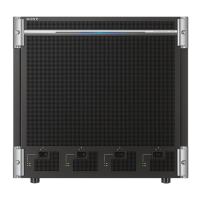145
DME wipe execution mode and supported pattern numbers
There are three DME wipe execution modes, depending on
the number of DME channels available: 1-channel mode
(1ch), 2-channel mode (2ch), and 3-channel mode (3ch).
The supported channel modes and pattern numbers
supported in each pattern group are shown in the following
table.
For details about pattern images (excluding user
programmable DME), see “DME Wipe Pattern List”
(page 435) and “Resizer DME Wipe Pattern List”
(page 440).
P in P (Picture-in-picture) • In 1-channel mode, this completes in two transitions.
- In the first transition, the old video shrinks, and the new video appears behind it.
- In the second transition, the old video expands again until it is its original size.
• In 2-channel mode, in the first half of the transition, the old video shrinks, and the
new video appears.
- In the second half of the transition, the new video expands, and the old video
disappears.
- You can move the pattern from the current position by a relative amount.
- During the transition, the signal from the utility bus of the M/E bank appears as
the background.
2D trans (2D transforms) The new video appears over the old video, while undergoing expansion, two-
dimensional rotation and translation.
3D trans (3D transforms) • In 1-channel mode, the new video appears over the old video, while undergoing
expansion, three-dimensional rotation and translation.
• In 2-channel mode, the old video changes to the new video while both undergo
expansion, three-dimensional rotation and translation.
Sparkle The new video appears over the old video with a nonlinear effect applied, such as
broken glass, explosion, or melt. Next, the source picture returns as the effect
gradually reduces.
Split Slide The new video appears in strip form while sliding interleaved in the opposite
direction over the old video.
Mosaic In the first half of the transition, a mosaic is gradually applied to the old video, then
at the 50% point the inner image changes to the new video. In the second half, the
mosaic effect on the new video is gradually reduced, returning to the original image
at 100%.
Defocus In the first half of the transition, the old video is gradually defocused, then at the 50%
point the inner image changes to the new video. In the second half, the defocusing
effect on the new video is gradually reduced, returning to the original image at
100%.
Brick • In 2-channel mode, a brick such that the side surface is visible slides in over the
old video, then rotates so that the new video can be seen.
• In 3-channel mode, a brick appears over the old video as the image is expanding
and rotating, and switches to the new video.
User Program (user programmable DME) Executes a DME wipe using a DME keyframe effect created with a keyframe
operation.
For details about creating keyframe effects, see “Creating User Programmable DME
Patterns” (page 155).
Resizer Slide Executes a Slide DME wipe using a resizer.
Resizer Squeeze Executes a Squeeze DME wipe using a resizer.
Resizer Frame I/O Executes a Frame I/O DME wipe using a resizer.
Pattern group Effect

